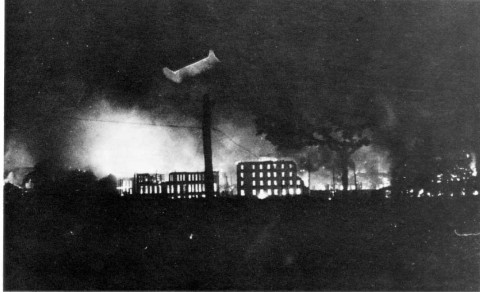[Cross-posted at Cliopatria.]

A couple of years ago I outed myself as something of a philistine by admitting that I didn’t ‘get’ Guernica, and thought that direct representations — photographs — of the ruined city were more powerful, more affecting than Picasso’s masterpiece. My incomprehension generated a fair degree of discussion, which was useful, but it was having to teach Guernica this week in tutorials which finally helped me make my peace with it. More specifically, learning something of Picasso’s process of design and composition, and the politics of his commission from the Republican government, led me to a better appreciation of its symbolism. Although it depicts — or rather is inspired by — the bombing of a city, it seems to be set inside as much as outside, somehow. The woman holding a lantern could be leaning out of a window, one who survived the destruction but suffers from what she has seen. Or she could be leaning in, perhaps symbolising the inaction of the international community after seeing what had happened to Guernica. Creative ambiguity, indeed.
But the other source the students looked at this week was the 1959 French-Japanese film Hiroshima mon amour. And while I’ve come to understand something of Guernica‘s power, figurative and non-literal though it may be, I now have a problem with Hiroshima mon amour. In the most simplistic terms, it is a love story between a French woman and a Japanese man, who have a doomed affair in Hiroshima, ca. 1957. But the romance is not the point. Marguerite Duras, author of the screenplay, later wrote that:
Nothing is ‘given’ at Hiroshima. Every gesture, every word, takes on an aura of meaning that transcends its literal meaning. And this is one of the principal goals of the film: to have done with the description of horror by horror, for that has been done by the Japanese themselves, but make this horror rise again from its ashes by incorporating it in a love that will necessarily be special and ‘wonderful’, one that will be more credible than if it had occurred any where else in the world a place that death had not preserved.
But if she wanted ‘to have done with the description of horror by horror’, then why did she and director Alain Resnais include — at times harrowing — documentary footage of the ruined city and the victims of the atomic bomb? (Starting from 7.53, continued in the second clip.)
Is this not a description of horror by horror? It’s true that the rest of the film does away with this literalness, but it seems like the concrete needs to exist before the abstract, which I find some consolation.
Something else strikes me about this sequence. It’s not just about Hiroshima. The fish being dumped for fear of radiation poisoning surely refers to the panic in Japan after the Lucky Dragon 5 incident in 1954. And the sequence starting with ‘It will begin again’ is a clear reference to a future nuclear war. So it’s also about the Cold War and about World War III. And what this has to do with the rest of the film, with the Frenchwoman’s present-day affair with the Japanese architect and the flashbacks to her wartime affair with the German soldier, is not clear to me. More reflection (and education!) needed.
For those with more refined artistic sensibilities than me, Hiroshima mon amour is available online. And Guernica can be seen at the Reina Sofia in Madrid, or, in tapestry form, at the Whitechapel Gallery in London.
Image source: Wikipedia.
![]() This work is licensed under a Creative Commons Attribution-NonCommercial-NoDerivatives 4.0 International License.
Permissions beyond the scope of this license may be available at http://airminded.org/copyright/.
This work is licensed under a Creative Commons Attribution-NonCommercial-NoDerivatives 4.0 International License.
Permissions beyond the scope of this license may be available at http://airminded.org/copyright/.




Pingback: Anticipation vs experience vs memory – Airminded